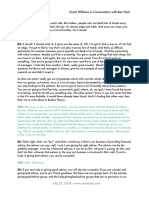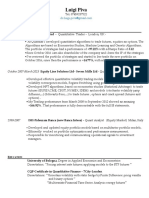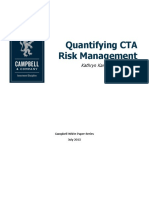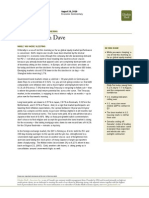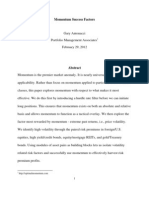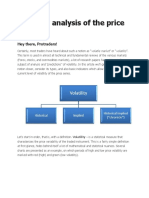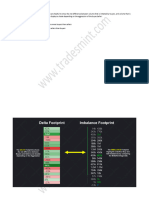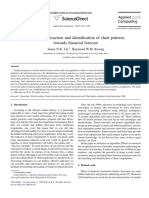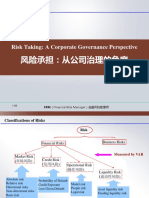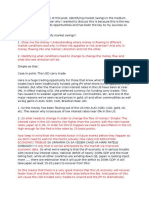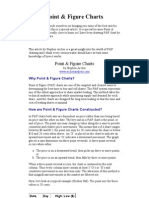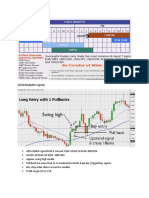How I use 42 Macro. Andreas Himmelreich 20.
August 2021
1. Subscribe at least to Weekly Horn and Leadoff Morning.
2. I start with the model portfolio to see how Darius is positioned (Weekly Horn).
3. VAMS → bullish, bearish (indicated above the chart!)? Green Line → Support (build position
buy if bullish). I never short, there is always a bull market (and if its only the dollar in deep
Deflation).
4. All VAMS → determine the Market Regime Probabilities.
At the end this is Tape reading, we read the tape of the market (from what I have learned all
successful traders do this!). Tech is strong in Goldilocks, Reflation and Inflation → that means
if Tech has a bullish VAMS → all those three Regimes get a point. Utilities are strong in
Inflation and in Deflation, if they have a bullish VAMS then those two Regimes get a point.
This is how Market Regime Probability is calculated. This Tape is for me the most important.
THIS IS WHERE THE MARKET IS RIGHT NOW.
5. Bottom-up market regime → Darius takes a trillion (or a lot )
economic data series (PMI, GDP, Inflation and stuff like that) weights them and this
determines the Bottom-up market regime grid. Monthly not quarterly! I use it to get a
general Idea where the market can be likely in 1-3 Months. If both (Bottom-up market
regime and the market regime probabilities) line up, you have in my view the strongest
signal possible (like in November 2020).
6. IVOL Premiums → I am not really using this in my trading other then I like to see IVOL
Premiums. If realized volatility (the day by day going up and down of let’s say the SP500) is
lower than the implied vola of options (so they are more expensive then the realized
volatility would suggest) → THIS MEANS HIGH Demand for protection. Now you might think,
well if the demand for protection is high, we might be prone for a crash. No, it’s the other
way around, if everybody has more fear then the loving of the motherland, then this is one(!)
bullish factor. I am not an expert in point 6, so if I am wrong, please correct me and I update
this point.
7. All that stuff is back tested. Its not an opinion its measure and map data. This stuff worked in
the past. Will it work in the future? Yes, yes because there are reasons why it works! For
example, if the rate of change of GDP (and the slope, the steepness of it) is accelerating and
inflation is decelerating (Goldilocks Baby, Goldilocks!) what happens in the real world? If
Inflation is going down the FED does not have to raise interest rates (so the Earnings of
Companies do get discounted with a lower interest rate, that means prices go up, because
the present value of their future earnings are getting higher). If GDP is going up, what do you
think happens to earnings of companies. They go up. And if they go up, their price goes up.
You can map those cause and effects for all 4 Regimes perfectly! There is a reason why it
works. Never trust a model where you do not understand the reason!
8. The rest is the interpretation of the data from Darius. If you like discussions whether the Fed
is going to taper fine. If not fine too. I like it, I like the intellectual side of markets, but I pay
attention not to get dragged away by them. At the end it’s about the data.
�9. Think deeply: Right now, for example I see a lot of guys who buy tons of
gold. I would never do this other then we would have a super deep, ranging Inflation Regime.
Why, because Gold only goes up in this kind of a regime (and has pretty high competition
from bitcoin, Gen Y buys crypto not gold). But we do not have a super clear picture right
now! It (Market Regime Probabilities, e.g., the tape!) could be goldilocks now; in 6 weeks it
could be shallow inflation or deflation. The only thing we can be sure of it will not be in a
Reflation. Also, the regime coming (see the Bottom-up market regime) is very, very likely to
be shallow. A shallow deflation regime is something totally different then a deep one. In a
shallow deflation regime, quality stocks can still make money. But hey it could turn to a deep
one, right? So, what the hell now?
I also know that long duration bonds (let’s say TLT) as a hedge for a portfolio only costs you a
ton of money (e.g., TLT price going down) in a reflation regime. In goldilocks you usually do
not lose much, in deflation you hit the jackpot and also inflation is not too bad for long
duration bonds. So, what to do now? It’s a confusing market!!! Position for the most likely
outcomes (plural, not singular!). So, I hedge my top-notch quality stocks with TLT and the
dollar (I live in Europe very easy for me, my whole port is denominated in dollar). If we hit a
crash in a deep deflation regime the dollar and TLT will save me a lot of drawdowns. If we
have shallow goldilocks, deflation, inflation environment my stocks will do o.k. and my
hedges will do o.k. I am positioned for three regimes! Have a look at the following screen
(subscribers know it!) .
10. Ask yourself what your strengths are. My one is not macro, so I subscribe to 42Macro.
But you might be a great CANSLIM growth trader. I know CANSLIM Traders that use 42
Macro kind of stuff. They go all in in a deep reflation (with 50-100% margin and 5-10 Stocks),
they are aggressive in a goldilocks market (with 100% invested) and they lighten up in an
inflation or deflation regime (up to 95% Cash). I know one trader who made > 900% in the
last reflation regime (May 2020 to Jan 2021)! Why would this guy buy ETFs if he has that kind
of a strength? And the only thing to hold on to his gains now is to lighten up his exposure and
press if the regime is right!
My strengths are in building (capacity constrained, e.g., they only work if your port is below 1
Million) models on portfolio123.com. I have small cap stocks models that are doing > 100% in
(annualized) in a reflation regime or > 60% in a goldilocks regime.
My models are still generating profits (0-30%) in an inflation and deflation regime, but only if
I hedge them with TLT. So, this is exactly what I am doing: use 42Macro for the capital
allocation of my p123 systems. So why should I buy ETFs? If you have a great strength in a
certain space of the market, use it in combination (e.g., for the capital allocation: how much
cash?) and do not implement the model portfolio of 42Macro. If you do not want to invest
much time in markets, then use the model portfolio of 42Macro.



